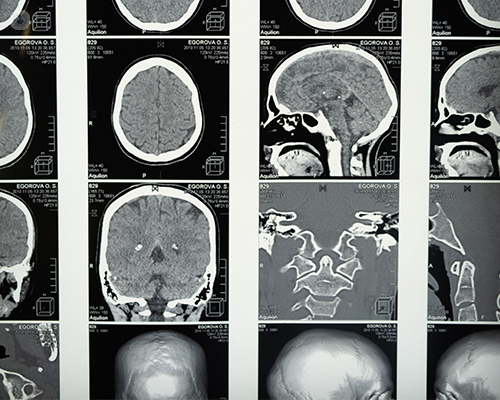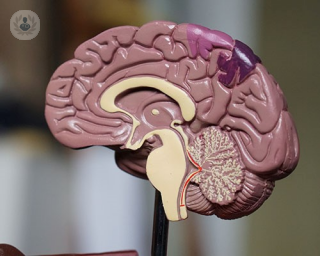What is a cavernoma?
A cavernoma is a cluster of abnormal blood vessels, usually found in the brain and spinal cord. They are also known as cavernous angiomas, cavernous hemangiomas, or cerebral cavernous malformation (CCM). A typical cavernoma looks like a raspberry and is filled with blood that flows slowly through vessels that are like caverns.

What are the symptoms?
Often a cavernoma doesn’t cause any symptoms but when symptoms do arise, they can include:
- Haemorrhage, when a blood vessel in the brain ruptures, causing bleeding
- Seizures
- Headaches
- Neurological problems like dizziness, balance problems, slurred speech, and double vision
- Weakness
- Memory problems and problems concentrating
- Tiredness
- A type of stroke called a haemorrhagic stroke
Seek medical help immediately if you experience any of the aforementioned symptoms.
The severity and duration of cavernoma symptoms can vary, depending on the location of the cavernoma and the type. The cells lining the cavernoma are normally thinner than those of normal blood vessels which means that they are more prone to leaking. Severe bleeding or haemorrhages due to blood leaking can be life-threatening.
How is a cavernoma diagnosed?
Cavernomas are mostly diagnosed with an MRI scan that is being done for other neurological reasons. A detailed picture can be made of the brain and spine. Sometimes a contrast dye might be injected into a vein in your arm to get a better look at the blood vessels.
A CT scan or angiography can also be used, but are not as reliable as an MRI scan.
If there is a family history of the condition, genetic testing can be carried out to identify any changes associated with cavernomas in genes.
What causes a cavernoma?
For most cases, there is no clear reason as to why a cavernoma develops. Less than 50 per cent of cases are thought to be genetic.
Some cases have been linked to radiation exposure, like having previously undergone radiotherapy on the brain.
Can a cavernoma be prevented?
There is nothing to prevent a cavernoma but genetic testing can be carried out to determine whether a person is at risk of developing a cavernoma. There is thought to be a 50 per cent chance of a child developing a cavernoma if one parent has the genetic type of cavernoma.
How is a cavernoma treated?
Treatment will vary depending on the person, the size and location of the cavernoma. If there are no symptoms, your doctor might recommend monitoring the cavernoma with MRI scans on a regular basis to watch out for any changes in the malformation.
Symptoms such as headaches and seizures caused by the cavernoma can be managed with medication. More invasive treatments might be offered to reduce the risk of haemorrhages in the future. These treatments can include:
- Neurosurgery: under general anaesthetic, the cavernoma is removed
- Stereotactic radiosurgery: a concentrated dose of radiation is aimed directly at the cavernoma so that it becomes thickened and scarred. This treatment is usually only carried out if the cavernoma is too difficult to remove with neurosurgery.
What specialist would I see for a cavernoma?
A neurologist or cerebrovascular neurologist, trained in the brain and nervous system will treat a cavernoma.
02-28-2019 02-28-2019Cavernoma
What is a cavernoma?
A cavernoma is a cluster of abnormal blood vessels, usually found in the brain and spinal cord. They are also known as cavernous angiomas, cavernous hemangiomas, or cerebral cavernous malformation (CCM). A typical cavernoma looks like a raspberry and is filled with blood that flows slowly through vessels that are like caverns.

What are the symptoms?
Often a cavernoma doesn’t cause any symptoms but when symptoms do arise, they can include:
- Haemorrhage, when a blood vessel in the brain ruptures, causing bleeding
- Seizures
- Headaches
- Neurological problems like dizziness, balance problems, slurred speech, and double vision
- Weakness
- Memory problems and problems concentrating
- Tiredness
- A type of stroke called a haemorrhagic stroke
Seek medical help immediately if you experience any of the aforementioned symptoms.
The severity and duration of cavernoma symptoms can vary, depending on the location of the cavernoma and the type. The cells lining the cavernoma are normally thinner than those of normal blood vessels which means that they are more prone to leaking. Severe bleeding or haemorrhages due to blood leaking can be life-threatening.
How is a cavernoma diagnosed?
Cavernomas are mostly diagnosed with an MRI scan that is being done for other neurological reasons. A detailed picture can be made of the brain and spine. Sometimes a contrast dye might be injected into a vein in your arm to get a better look at the blood vessels.
A CT scan or angiography can also be used, but are not as reliable as an MRI scan.
If there is a family history of the condition, genetic testing can be carried out to identify any changes associated with cavernomas in genes.
What causes a cavernoma?
For most cases, there is no clear reason as to why a cavernoma develops. Less than 50 per cent of cases are thought to be genetic.
Some cases have been linked to radiation exposure, like having previously undergone radiotherapy on the brain.
Can a cavernoma be prevented?
There is nothing to prevent a cavernoma but genetic testing can be carried out to determine whether a person is at risk of developing a cavernoma. There is thought to be a 50 per cent chance of a child developing a cavernoma if one parent has the genetic type of cavernoma.
How is a cavernoma treated?
Treatment will vary depending on the person, the size and location of the cavernoma. If there are no symptoms, your doctor might recommend monitoring the cavernoma with MRI scans on a regular basis to watch out for any changes in the malformation.
Symptoms such as headaches and seizures caused by the cavernoma can be managed with medication. More invasive treatments might be offered to reduce the risk of haemorrhages in the future. These treatments can include:
- Neurosurgery: under general anaesthetic, the cavernoma is removed
- Stereotactic radiosurgery: a concentrated dose of radiation is aimed directly at the cavernoma so that it becomes thickened and scarred. This treatment is usually only carried out if the cavernoma is too difficult to remove with neurosurgery.
What specialist would I see for a cavernoma?
A neurologist or cerebrovascular neurologist, trained in the brain and nervous system will treat a cavernoma.


What is a cavernoma and how is it treated?
By Mr Patrick Grover
2024-11-20
Mr Patrick Grover is a leading London-based consultant neurosurgeon with over 10 years of experience. In his latest article, Mr Grover offers his expert insight into cavernomas, explaining their symptoms and treatment options among other points. See more


Is a cavernoma serious?
By Mr Ciaran S. Hill
2024-11-20
A cavernoma is a condition of the blood vessels which can happen in the brain or spinal cord. Are they serious? Leading neurosurgeon Mr Ciaran S. Hill has the answers. See more


What is vascular neurosurgery?
By Dr Stuart Coley
2024-11-19
What exactly is vascular neurosurgery? In this informative article, highly respected radiologist Dr Stuart Coley explores some of the conditions which fall under this complex subspecialty. See more
Experts in Cavernoma
-
Ms Mary Murphy
NeurosurgeryExpert in:
- Arteriovenous malformation
- Cavernoma
- Gamma knife
- Meningioma
- Vascular malformations
- Brain metastasis
-
Mr Neil Kitchen
NeurosurgeryExpert in:
- Brain tumour
- Acoustic neuroma
- Cavernoma
- Gamma knife
- Trigeminal neuralgia
- Brain metastasis
-
Mr Patrick Grover
NeurosurgeryExpert in:
- Acoustic neuroma
- Arteriovenous malformation
- Brain tumour
- Cavernoma
- Gamma knife
- Meningioma
-
Mr Jeremy Rowe
NeurosurgeryExpert in:
- Gamma knife
- Trigeminal neuralgia
- Cavernoma
- Brain tumour
- Acoustic neuroma
- Meningioma
-
Mr Matthias Radatz
NeurosurgeryExpert in:
- Arteriovenous malformation
- Brain tumour
- Gamma knife
- Trigeminal neuralgia
- Meningioma
- Cavernoma
- See all

Amethyst: Thornbury Radiosurgery Centre
Amethyst: Thornbury Radiosurgery Centre
Thornbury Radiosurgery Centre, 312 Fulwood Rd, Sheffield, S10 3BR
No existe teléfono en el centro.
By using the telephone number provided by TOP DOCTORS, you automatically agree to let us use your phone number for statistical and commercial purposes. For further information, read our Privacy Policy
Top Doctors

Amethyst: Queen Square (GammaKnife) Radiosurgery Centre
Amethyst: Queen Square (GammaKnife) Radiosurgery Centre
National Hospital for Neurology, Amethyst UK Gamma Knife Centre
No existe teléfono en el centro.
By using the telephone number provided by TOP DOCTORS, you automatically agree to let us use your phone number for statistical and commercial purposes. For further information, read our Privacy Policy
Top Doctors

Amethyst: The Queen Square Neuroscience Health Centre
Amethyst: The Queen Square Neuroscience Health Centre
42-43 Queen Square London WC1N 3AQ
No existe teléfono en el centro.
By using the telephone number provided by TOP DOCTORS, you automatically agree to let us use your phone number for statistical and commercial purposes. For further information, read our Privacy Policy
Top Doctors
-
Amethyst: Thornbury Radiosurgery Centre
Thornbury Radiosurgery Centre, 312 Fulwood Rd, Sheffield, S10 3BR, SheffieldExpert in:
- Vascular Surgery
- Neurosurgery
- Neurology
- Medical Oncology
- Cancer Treatment
- Brain and spinal tumours
-
Amethyst: Queen Square (GammaKnife) Radiosurgery Centre
National Hospital for Neurology, Amethyst UK Gamma Knife Centre, Central LondonExpert in:
- Vascular Surgery
- Cancer pain
- Neurosurgery
- Neurology
- Medical Oncology
- Cancer Treatment
-
Amethyst: The Queen Square Neuroscience Health Centre
42-43 Queen Square London WC1N 3AQ, Central LondonExpert in:
- Vascular Surgery
- Cancer pain
- Neurosurgery
- Neurology
- Medical Oncology
- Cancer Treatment
- See all
- Most viewed diseases, medical tests, and treatments
- Migraine
- Lumbar herniated disc
- Spinal surgery
- Minimal access surgery (keyhole surgery)
- Tremor
- Seizures
- Parkinson's disease
- Botulinum toxin (Botox™)
- Abnormal gait
- Ulnar nerve surgery







